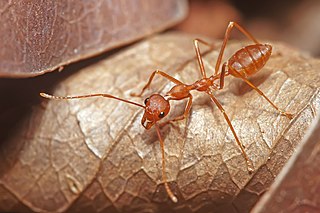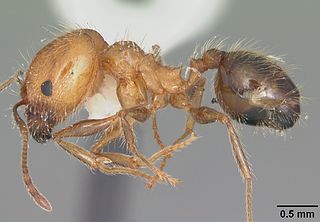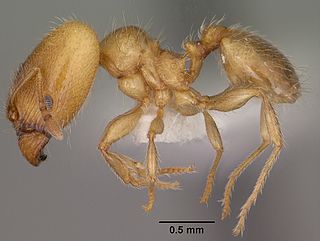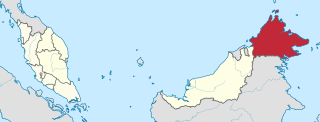
Pheidole is a genus of ants that belongs to the ant subfamily Myrmicinae. The genus is widespread and ecologically dominant. It probably includes more than a thousand species. The genus first evolved in the Americas, eventually spreading across the globe.

Weaver ants or green ants are eusocial insects of the family Formicidae. Weaver ants live in trees and are known for their unique nest building behaviour where workers construct nests by weaving together leaves using larval silk. Colonies can be extremely large consisting of more than a hundred nests spanning numerous trees and containing more than half a million workers. Like many other ant species, weaver ants prey on small insects and supplement their diet with carbohydrate-rich honeydew excreted by small insects (Hemiptera). Weaver ant workers exhibit a clear bimodal size distribution, with almost no overlap between the size of the minor and major workers. The major workers are approximately 8–10 mm (0.31–0.39 in) in length and the minors approximately half the length of the majors. Major workers forage, defend, maintain, and expand the colony whereas minor workers tend to stay within the nests where they care for the brood and 'milk' scale insects in or close to the nests.

Paratrechina is one of seven ant genera in the Prenolepis genus-group from the subfamily Formicinae. Six species are included in Paratrechina; one of which, the longhorn crazy ant, is a widespread, pantropical pest.

The Eucharitidae are a family of parasitic wasps. Eucharitid wasps are members of the superfamily Chalcidoidea and consist of three subfamilies: Oraseminae, Eucharitinae, and Gollumiellinae. Most of the 55 genera and 417 species of Eucharitidae are members of the subfamilies Oraseminae and Eucharitinae, and are found in tropical regions of the world.
Barry Bolton is an English myrmecologist, an expert on the classification, systematics, and taxonomy of ants, who long worked at the Natural History Museum (London). He is known especially for monographs on African and Asian ants and for three encyclopaedic global works, including the Identification Guide to Ant Genera (1994), a full catalogue of ant taxa, and a synopsis and classification (2003). Now retired, Bolton is a Fellow of the Royal Entomological Society and Myrmecologist, Biodiversity Division, Department of Entomology, Natural History Museum, London.
Mark Moffett is a tropical biologist who studies the ecology of tropical forest canopies and the social behavior of animals and humans. He is also the author of several popular science books and is noted for his macrophotography documenting ant biology.

Pheidole megacephala is a species of ant in the family Formicidae. It is commonly known as the big-headed ant in the USA and the coastal brown ant in Australia. It is a very successful invasive species and is considered a danger to native ants in Australia and other places. It has been nominated as one of the hundred "World's worst" invaders.

Thaumatomyrmex is a Neotropical genus of ants in the subfamily Ponerinae, found from Mexico to Brazil. They are notable for their pitchfork-shaped mandibles, which they use to capture millipedes of the order Polyxenida. The genus is a specialist predator of polyxenids, and one of only two ant genera known to prey upon polyxenids.

Oecophylla longinoda is a species of arboreal ant found in the forested regions of tropical Africa. They are one of only two extant species of the genus Oecophylla, the other being O. smaragdina. They make nests in trees made of leaves stitched together using the silk produced by their larvae.
Pheidole harlequina is a species of ant in the genus Pheidole. It was discovered and described by American biologist E. O. Wilson in 2003. Distribution:República Dominicana

Lenomyrmex is a Neotropical genus of ant in the subfamily Myrmicinae.

Pheidole antipodum is a species of ant in the genus Pheidole. It is known only from Australia, where the ants nest in drier regions in soil or under rocks. Little is known about their biology, but they are thought to be specialist predators of termites.

Leptogenys is a genus of ants in the subfamily Ponerinae. Leptogenys is the most diverse ponerine ant genus in the world; it is widespread throughout tropical and subtropical regions and there are over 260 extant species described. Most species have ergatoid queens, and many have falcate, bowed mandibles and are specialists on isopod prey.

Haidomyrmex is an extinct genus of ants in the formicid subfamily Sphecomyrminae, and is one of only five genera placed in the tribe Haidomyrmecini. The genus contains three described species Haidomyrmex cerberus, Haidomyrmex scimitarus, and Haidomyrmex zigrasi. All three are known from single Late Cretaceous fossils which have been found in Asia. H. cerberus is the type species and Haidomyrmex the type genus for the tribe Haidomyrmecini.

Trichomyrmex destructor is a species of ant in the subfamily Myrmicinae. Its common names include destructive trailing ant or Singapore ant. It is a pest species in urban areas, known for causing costly damage to structures, vehicles, and electronic devices with its chewing activity. In 2015, the species was moved from the genus Monomorium to the revised genus Trichomyrmex.

Pheidole dentata is a species of ant in the genus Pheidole. It is distributed in North America, from the Mid-Atlantic states and southeastern United States to Mexico.

Pheidole bicarinata is a species of ant in the genus Pheidole. It is distributed across United States, from Nebraska, Colorado, Texas, Utah and Nevada, east to New Jersey and Florida.
Pheidole spathifera is a species of ant in the subfamily Myrmicinae. It is found in Asian countries.

Pheidole clavata is a species of ant in the genus Pheidole. Pheidole clavata inhabits Eastern and Northern Africa. This species of Pheidole, like many others, are dimorphic, which means that a colony may contain one or several queens. Each colony is made up of two castes: the "minor" workers, and the "major" workers, or "soldiers". The majors have large heads that they use as both weapons and tools to cut open large prey for the colony. The latter generally have enormous heads and mandibles in comparison to their usually fairly modest body size.


















